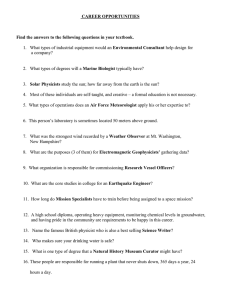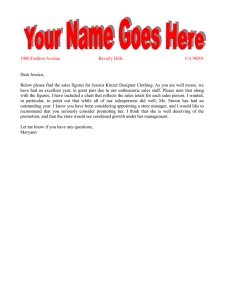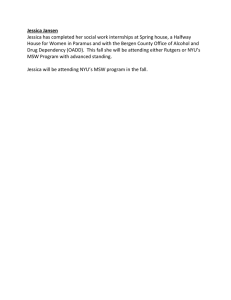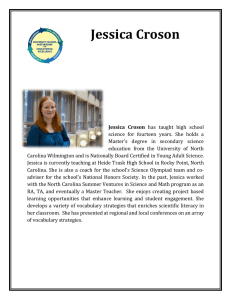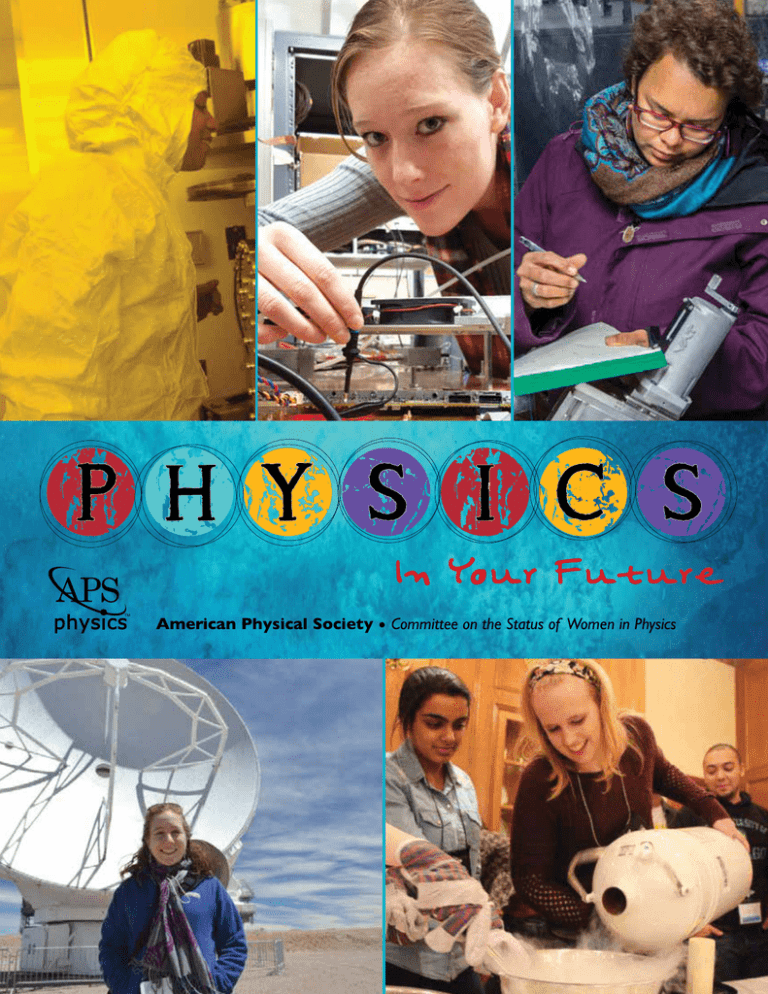
TM
American Physical Society • Committee on the Status of Women in Physics
Chiara La Tessa of Brookhaven National Laboratory is inside the target room of the NASA Space Radiation Laboratory at Brookhaven.
She is aligning a detector called EGG counter in the center of a beam – something that’s done before each experiment.
Physics helps us understand the world around us, the world inside
us, and the world beyond us.
Physics is the most basic and fundamental science; it deals with how and
why matter and energy act as they do.
The laws of physics apply to force and motion, gravity, electricity, magnetism,
sound, light and heat. They help us understand the physical world and develop
products that people need.
Mastering physics is fun and challenging. It involves working with others, as
well as alone. You learn how to solve problems, observe things carefully, make
measurements and keep accurate records. You can use these valuable skills for the
rest of your life. They open doors to many good jobs.
Physicists ask questions about the physical world and try to find exact answers. They
are creative and persistent. Some do basic research. Their goal is to increase our
knowledge of the universe. Others do applied research. They use basic knowledge
to solve world problems such as food and energy supply, environmental protection, transportation, communication and defense.
Physicists work in industry, educational institutions, government, and medical centers today. Most are active scientists and engineers.
They do research and development, administration, and teaching. Others use their physics background in fields like publishing, sales,
law, accounting and medicine. Salaries for beginning physicists are generally good, although they vary according to your education,
type of employer, and job responsibilities. You can get the latest salary information from the American Institute of Physics at
http://www.aip.org/statistics/.
You’ve probably seen TV shows and movies that have influenced your thoughts about scientists. Now let’s meet some real people
who are physicists. Find out what they actually do and what kind of people they truly are. Then see if you can picture yourself having
a career in science.
For more information about how physics is part of your world, go to
PhysicsCentral, www.physicscentral.com.
Start to plan your future
Think about how your career will fit into the lifestyle you want.
Talk to your science and math teachers, advisors and parents about the
opportunities physics can offer you. Go to your public library. You’ll find
popular books, magazines, and websites about current topics of interest
in science. Ask physicists about their work. Companies, universities, and
museums often let people visit their facilities and meet their staff. Call to
find out when you can visit.
Take advantage of resources that can help you explore future career
possibilities, like the APS Physicist Profiles and Professional Guidebook on
the APS Careers Website (www.aps.org/careers).
Act now to keep your career options open
Take all the math and science you can and work on your communication skills.
Math is the “language” of physics, and computers are the main tools for calculations. Understanding high school science will prepare
you to enter college and be a good citizen in any job. Join a science, computer, debate, or public speaking club in your community or
start one yourself. You’ll find other people who enjoy solving puzzles, exploring nature, doing projects, and sharing ideas. Work on
your own projects. If your school has a science fair, try to participate in it.
Elena Long
Elena Long is taking a deep look into the building blocks of matter—
the stuff that makes up her and you and me and everything else in
the world.
Elena is a nuclear physicist. She studies the insides of neutrons, microscopic
particles packed into the center of every atom except hydrogen.
Elena does her experiments at the Jefferson Lab in southern Virginia. The lab has
a machine called an accelerator that gives particles very high speeds. By smashing
high-speed electrons into helium atoms and studying the stuff that flies out the
other side, Elena and her colleagues can piece together how the helium neutrons’
internal components were arranged.
Elena got interested in nuclear physics when she took a modern physics course as
an undergraduate at Juniata College in Pennsylvania. “I realized how utterly bizarre
the world of the very small is,” she says. “Taking that course made me realize this
is a field of study that people get into.”
She then “jumped on the chance” to do research at the Jefferson Lab. Now she is
a researcher at the University of New Hampshire, but she continues to travel to
Virginia for her experiments. She hopes to eventually become a physics professor
and continue doing experiments. “The most exciting parts are being able to get my
hands dirty a lot of the time,” she says, noting that even as we’re talking, her hands
are covered in grease from one of her experiments.
Elena is not just opening up the secrets of the neutron; she’s also opening up
physics to more people. Elena is queer and transgender, and when she got to the
Jefferson Lab, she didn’t find much community for physicists like her.
Elena felt isolated, and she realized others were having similar experiences. She
started a group called LGBT+ Physicists. LGBT stands for “lesbian, gay, bisexual
and transgender.” The group had its first meeting in 2010. It now has its own web
page, with a list of almost 100 LGBT+ physicists and almost 200 “allies.” Elena also
worked with Jefferson Lab management to ensure that LGBT physicists would not
face employment discrimination.
There is still work to be done, but Elena now feels much more like she is part of
the physics community. It’s critical to both “follow your passion, and find your
people,” she says.
If you want a career in biology, Jennifer Ross has some advice for you:
“Be a physics major.”
Jennifer Ross
Jennifer is a biophysicist at the University of Massachusetts Amherst. She studies
how cells work, from a physical point of view. Specifically, she studies tiny rods called
microtubules that organize themselves to give cells their three-dimensional structure.
Jennifer didn’t actually like high school biology. She thought it was too much
memorizing and not enough fundamental understanding. So she studied physics and
math instead, at Wellesley College, a women’s college in Massachusetts.
But when Jennifer got to graduate school, at the University of California, Santa
Barbara, she discovered that she did like biology—the way physicists do it. She
liked thinking about the physical structures of cells, and the mathematical rules that
determine how those structures behave.
She began studying microtubules, which she calls “the LEGOs of the cell.”
Microtubules are extremely important—without them, our cells would collapse.
They are also critical to cell division. She learned that nobody understood how
microtubules form the complex structures that keep cells working.
Jim Gipe, Pivot Media
Jennifer made that her research focus. She uses lasers and microscopes to peer
into cells and measure the tiny forces that act on microtubules and other cell
components. She says it’s an exciting time because of the advanced technology she
and her students use to do their cutting-edge investigations.
Although she does basic research without specific applications in mind, her work
could lead to important biomedical advances like helping others design better
drugs. For example, a drug that disables microtubules could prevent cancer cells
from dividing.
The living world is wide open to people with a physics background according to
Jennifer. “The training that you get in physics is so excellent,” she says. “Biology is
in a place where they want to understand mechanisms; they want to be more like
physics…You can become a great biologist starting in physics.”
Students in Jennifer’s lab learn a lot, but she makes sure they don’t come away
thinking that scientific research is all work and no play. Every year the whole lab
takes a day away from research to make a funny video that they post on YouTube.
“My first goal is to make it fun,” she says. “The rules for undergrads in the lab are
try, fail, try again, have fun, don’t die.”
Jim Gipe, Pivot Media
Clara Moskowitz
When Clara Moskowitz was in high school, she loved to read books
by physicist Brian Greene, who made difficult subjects like string
theory understandable.
Now Clara works for the famous magazine Scientific American. And earlier this
year, she got to assign and edit an essay that Greene wrote about Albert Einstein.
Clara is a science writer. She doesn’t do original research, but she writes about
people who do. Clara translates complex findings in physics and astronomy into
interesting stories that non-scientists can read and understand.
Early on, Clara did dream of being a scientist. “I really was a space geek from way
back,” she admits. She went to space camp and attended Wesleyan University,
a small college in Connecticut, because she knew she could do research with
professors there even as an undergraduate.
Clara used Wesleyan’s telescope to collect and analyze data, and she presented
her research at conferences. Eventually she realized that, while she loved learning
about physics and astronomy, she didn’t so much love actually doing the research.
Scientific American
Everyone’s personality is unique. She found another way to keep learning about
science: write about people who love to do research. “I get to talk to people who
spent their whole career studying this one research question,” she says, “and I love
it, because I didn’t have to be down in the trenches, but I get to hear the punch
line, what they found.”
Clara’s first full-time job was with the online publication Space.com, where she
covered NASA’s space shuttle missions. This meant flying to Florida for each
launch, then to Houston for the missions themselves. Sometimes she would wake
up in the middle of the night to cover a spacewalk or an experiment. She got to
interview working astronauts like Katie Coleman as well as superstars like Buzz
Aldrin, the second man on the moon.
Now at Scientific American, Clara spends less time writing and more time editing
other people’s writing. She also makes podcasts and helps design and put together
magazine issues.
Clara says her background in physics helps greatly as she seeks to make science
accessible to others. “It’s tough material,” she says. “I need to read journal articles
and abstracts and know what they’re about. If I didn’t have my physics degree
there’s no way that would be possible.”
Danielle Fong has a big goal: She wants to change how people use
energy—ideally before the age of 35.
Danielle skipped high school and earned her undergraduate physics degree from
Dalhousie University in Canada. She moved on to Princeton for graduate school,
where she hoped to develop nuclear fusion into the energy source of the future.
But she found the pace to be too slow for her, so in 2007, at the age of 19, she left
school and moved to Berkeley, California.
A year later, having made some connections, she and two friends founded a
company called LightSail Energy to develop a new way to store energy. A year
later their company got funding from a major investor.
Energy storage is important because renewable, carbon-free energy sources like
solar and wind power are intermittent: the sun doesn’t always shine, and the wind
doesn’t always blow. For renewables to really take off, electricity providers need
a way to store energy so it can be released to the electric grid at night or when
winds are calm.
Danielle’s company found a way to store energy in large tanks of compressed air.
To do this, Danielle used her knowledge of physics. She used thermodynamics—
which describes how temperature and pressure work—to design an innovative
technology that compresses air without overheating it.
Danielle says she and her colleagues are constantly solving hard problems where
physics comes in handy. “If you’re interested and capable, physics is one of the best
ways to work with problems,” she says.
A successful business idea can both change the world and earn nice profits,
Danielle says. She also enjoys the teamwork involved in her work. “I spend a
lot of time communicating with people, connecting with people, showing people
the way forward,” she says. “It’s very social, and physics creates the language to
communicate and to see the possibilities.”
She recommends that middle and high school students take advantage of their
relative freedom (“you’re not expected to pay the rent,” she notes) to try out
new ideas. For those who want to learn what the business world is like, summer
internships are often available at companies like LightSail.
Ultimately, Danielle hopes more young people will use physics to pursue their
passions, whatever they may be. “Physics doesn’t necessarily confine you solely to
the lab,” she says.
Danielle Fong
Jessica Kirkpatrick
Every time you log onto Facebook, Amazon, Instagram or hundreds
of other websites, someone like Jessica Kirkpatrick is collecting data,
analyzing it and using it to make your experience better.
Jessica is a data scientist. She uses information collected from millions of Internet
users to look for trends and suggest ways to improve how websites function.
But before Jessica was a data scientist, she was a physicist. This background made
her an expert at analyzing large amounts of information. As an undergraduate at
Occidental College in California, Jessica worked on a research project, analyzing
data from a particle detector. Later, as a graduate student at the University of
California, Berkeley, she worked on a different project, the Sloan Digital Sky Survey,
which gathered what was then an unprecedented amount of astronomical data.
Jessica loved discovering that she could learn new things about the universe using just
her computer and some data. “I really loved coding,” she says. “The idea that you
could get a computer to do work for you … seemed like magic to me.” With practice
and expertise, she easily made the leap to working as a data scientist in industry.
Until recently, Jessica worked for InstaEDU, a company that matches students
with tutors over the Internet. When she started working there, the company was
concerned because many people tried the site during a free trial period but didn’t
become paying customers. InstaEDU asked Jessica to figure out why more people
weren’t returning to the site.
Jessica found that when first-time students were paired with first-time tutors,
both types of users returned to the site less often than when they were paired
with experienced users. She realized that first-timers sometimes had trouble
understanding how the website worked, and experienced users could often help
newcomers solve their technical problems resulting in a more satisfying experience.
Based on Jessica’s work, InstaEDU redesigned the way it paired students and tutors
– they no longer paired first-time students with first-time tutors. As a result, the
fraction of trial users who became paying customers went up by a third. “That was
a pretty big win for us,” says Jessica, who recently took a new job at Hired.com.
New data science jobs open up all the time, says Jessica. And it’s not just websites
that are hiring data scientists; so are traditional businesses, nonprofits, and even
local and national governments. Jessica adds, “I think that the skill set of being able
to use data to drive insights and help people make decisions is just growing and
growing.”
When Brittany Kamai took her first astronomy class as a freshman
at the University of Hawaii, her professor told her that we can only
see about 4% of the stuff in the universe. The rest is made of mysterious
substances called dark matter and dark energy. “I found it fascinating that in the
entire textbook for our class, there was barely a paragraph about this crazy thing,”
she recalls.
Inspired, Brittany decided to study physics. During the summer before her last
year of college, she accepted an opportunity to do research at the Institute for
Astronomy at the University of Hawaii. She was hooked.
Brittany went on to join the Fisk-Vanderbilt Master’s-to-PhD Bridge Program, a
two-year program designed to help students with limited undergraduate research
experience. She is now in the PhD program at Vanderbilt University in Tennessee.
But she actually spends most of her time in Chicago, because her research is based
at Fermilab, a large U.S. Department of Energy research facility in northern Illinois.
Brittany is building what she calls “the world’s most precise ruler”—also called
a “holometer.” She and her colleagues hope to use intersecting laser beams to
measure space itself very precisely, so they can look for tiny differences between
what they measure and what Einstein’s theory of general relativity predicts about it.
Brittany and her colleagues are now testing the machine and making it as accurate
as possible. They have just begun to run their experiment and hope to have results
very soon. She will soon finish graduate school, but plans to continue pursuing
experimental research in astrophysics. She likes the variety of work she gets to do.
“Sometimes it’s nice to say OK, I don’t have to go into the lab, I can be behind my
computer,” she says. “And sometimes it’s like, I’m sick of this—let me go back in
lab! I enjoy that.”
When Brittany’s not doing science, she’s often talking about it, and encouraging
young people—especially girls—to pursue it. She sees this as an important part
of her job. In the past five years, she has shared her enthusiasm for science at
museums, at middle schools and high schools, and even at senior centers. “You
talk to people who are 50-plus, they get super-jazzed about it, they tell their kids,
their grandkids,” she says. “And it’s like yes! This is how you get people excited
about science.”
Brittany Kamai
Kate Miller
It’s one thing to understand physics yourself, says Kate Miller. It’s
another thing to be able to help someone else understand it.
Kate is devoting her career to helping others understand physics. She is a thirdyear physics teacher at Washington-Lee High School in Arlington, Virginia, just a
few miles from the nation’s capital. Kate teaches both introductory physics and an
advanced program called international baccalaureate physics, where students learn
about topics like climate change, thermodynamics and astrophysics.
Students in Kate’s classes don’t just listen to lectures and fill out worksheets. They
also design, build and market model roller coasters, experience Newton’s laws by
playing tug-of-war, and pursue year-long independent research projects.
Kate fell in love with physics in high school, when she took her first course in the
subject. “I could start to explain the moves I did in gymnastics using mathematical
equations—that was really exciting,” she says. “That’s my favorite thing now, to
see my kids find their niche, something that sparks their curiosity.”
Peter Waterman
She also found out that she loved helping people learn things because she started
coaching gymnastics at age 16. For Kate, a career teaching physics was simply a
matter of “marrying my two passions.”
After she received her bachelor’s degree in physics from the University of
Michigan, Kate went to the University of Pennsylvania for her master’s degree
in education. There, she learned how to recognize and address student
misconceptions and how to present material in multiple ways to help students
with different learning styles. She also learned that teaching is no less intellectually
demanding than a career in research or industry. “It’s just as rigorous, challenging
and tiring as any other options a physicist has in front of them,” she says.
Kate then landed what she calls her “dream job” at Washington-Lee: an urban/
suburban school with a diverse student population and several other physics
teachers with whom she can collaborate.
Kate’s students are fortunate, too: only around a third of the nation’s new high
school physics teachers have a degree in physics or physics education. Physics
teachers are among the hardest teachers for schools to find, which means that
people with the right training can count on plenty of job opportunities. Simply put,
Kate says, “It’s a good time to be a physics teacher.”
Adele Luta
Amelia Plunk
Is there anything Adele Luta hasn’t done?
She’s worked in hospitals, started her own
tech company, and helped NASA train
astronauts. She now works in the defense
industry as a cognitive neuroscientist, trying to
answer questions like why some people thrive
under pressure, while others struggle. Adele’s
ability to do so many things all goes back to
physics, she says. “One of the great things about physics is that
we can cross-train in so many areas.”
After getting her undergraduate physics degree,
Amelia Plunk decided she wanted to try
something new. So she went to Northwestern
University’s materials science program, where
she developed a new kind of battery made out
of iron. With further development, the battery
could become part of future clean-energy
technologies. As a materials scientist, Amelia
used physics to design things that are “cost-effective, scalable,
and ready for deployment into the world,” she says. She is now
working on becoming a science teacher.
NASA
Jamelle Watson-Daniels
Bethany Goldblum
Jamelle Watson-Daniels is an undergraduate
at Brown University, but she has already done
physics research in Switzerland and Germany.
Now she’s developing solar-powered
environmental cleanup technology, and she
plans to study physics in graduate school.
She’s also getting a degree in Africana studies.
Jamelle says physics has prepared her for
many possible careers. “In my mind, if I can do physics, I can do
engineering, I can do anything else,” she says.
Bethany Goldblum uses physics to make the
world safer. Bethany is a nuclear engineer at
the University of California, Berkeley. She
studies how to detect nuclear weapons or
radioactive material that may be smuggled in
cargo, and advises policymakers about how
to improve security at ports and other places.
“Seeing how the scientific work that we do is
used in a policy setting is really inspirational,” she says.
Roy Kaltschmidt
Rhiannon Meharchand
Nicole Campbell
Rhiannon Meharchand helps the government
make some of its hardest decisions. Rhiannon
works for the Institute for Defense Analyses,
which advises the military on national security
issues like which military airplane to buy or
which satellite network to invest in. Rhiannon
uses her physics expertise to build computer
models, analyze problems and communicate
her findings to policymakers. “There are all kinds of extremely
interesting jobs that you might have never heard of, so prepare
as best you can in as many areas as you can,” she advises.
Nicole Campbell is an engineer for Raytheon
Missile Systems; she works on defense
systems for the United States and its strategic
global allies. She works on things like control
systems for unmanned aircraft, environmental
sensors for the battlefield and nanotechnology
for bulletproof clothing. Most of her work
involves the application and development of
electromagnetic theory to missile system design and proliferation
as well as development of advanced defensive and offensive
systems. She has degrees in physics and electrical engineering,
and while in graduate school, companies were already recruiting
her to work in industry. “When you get these types of degrees
it’s wide open what you can do with your career,” she says.
Robert Kramer, Los Alamos National Laboratory
Seraina Murphy
If a satellite isn’t working, Seraina Murphy
can probably tell you why. Seraina works for
the Boeing Company as a “failure analyst.”
She figures out why satellite equipment isn’t
working so it can be fixed before launch. The
job is a great fit because she loves working
with her hands and not with computers, she
says. “Play to your strengths,” she advises. “If
you like something, go for that.”
Netta Engelhardt
Netta Engelhardt is a theoretical physicist at
the University of California, Santa Barbara.
She is working on string theory, a “theory
of everything”. There are two fundamental
theories in physics—quantum mechanics and
general relativity—that don’t agree on some
things. String theory attempts to merge them.
Netta wants to use string theory to answer
questions like what happened during the Big Bang. “That’s really
the question that drives me,” she says. “Sometimes I can’t sleep
at night I’m so excited about it.”
David Copp
SUNY Oswego Communications Office
Katharyn Christiana, Physics Major, SUNY Oswego graduate and
Clarkson University Masters of Science graduate working on her honors
thesis project on the physics of the amusement park rides at Disneyland.
SUNY Oswego Communications Office
Marie Romano, Physics Major and Cognitive Science Major focusing
on the ultrahigh vacuum chamber, which she uses to investigate water
desorption from polymer films.
SUNY Oswego Communications Office
Julia D’Rozario, Physics Major and Cinema Studies Major working on a
project on capillary condensation. She uses Mathematica to analyze the
configurations of the liquid film in a cylinder and to obtain the shape of
the meniscus in cylindrical geometry.
Valdosta State University Physics Major Ashley Hardy aligns a laser during
an experiment to study the interaction between two laser beams.
Physicist Diana Thompson measures for radioactive contamination inside the
dozer bucket. Radioactive material is all around us and is used inside medical
and industrial devices. Sometimes these devices are disposed of incorrectly
or are broken or lost. Diana helps answer questions and keeps people safe by
measuring radiation to find out what type of radiation it is and where it is.
Jiri Kral
Christine Nattrass of the University of Tennessee, Knoxville sits inside
the ALICE magnet next to the EMCal. The ALICE experiment is designed
to measure Quark Gluon Plasma, the hottest liquid ever made in a
laboratory.
Physics PhD student Sarah Jones tests electronics at the CERN RD51 lab
near Geneva, Switzerland. Sarah is working on a setup for the prototype
electronics boards (i.e. board with LEDs) for the MicroMegas frontend readout system of ATLAS. The boards are designed by a group of
engineers and physicists at the University of Arizona. Sarah is responsible
for testing the boards and ensuring they function with real particle
detectors (the board is attached to one such detector in the photos).
Students at the APS Conference for Undergraduate Women in Physics at
Cornell University discuss research results during a poster session.
UWEC Photography
Being a physicist means you can work on cutting edge technology that can
help shape our lives. These students are researching ways to store braking
energy that can be used to help propel a scooter.
PhD student Jiani Huang works in Prof. Maiken Mikkelsen’s lab at Duke
University. In the photo, Jiani is aligning a linear polarizer into an optical
setup, to examine how different polarized light would affect the optical
properties of the nanomaterial, such as how much light was absorbed and
emitted upon photoexcitation.
Melody Wagner of Seattle Central College is touching a metal ball with a
mechanism inside that creates a static charge on the ball’s surface. When
she touches the ball, electricity flows through Melody and make her hair
stand on end! This happens because the negative charges on her hair repel
each other which makes each strand want to be as far away from the
others as possible.
Eliza Cohn, a Charlottesville high school student worked in the lab of
Despina Louca in the department of Physics at the University of Virginia.
She is preparing a floating zone furnace used to grow single crystals for
condensed matter research. Eliza is now a student at Johns Hopkins
University.
Physics in Your Future introduces physics and careers in physics to young people, their parents, teachers and advisors. Although
physics is often not taught until high school, the necessary mathematical preparation begins at the middle school level. The purpose
of this booklet is to inspire students who might otherwise avoid technical subjects to take all the mathematics and science courses
they can.
The American Physical Society (APS) is a non-profit membership organization working to advance and diffuse the knowledge of
physics through its outstanding research journals, scientific meetings, and education, outreach, advocacy, and international activities.
It establishes committees, such as the Committee on the Status of Women in Physics (CSWP), to consider issues of concern to APS
members. Learn more about APS by visiting www.aps.org.
CSWP sponsors a variety of projects including the APS Conferences for Undergraduate Women in Physics (CUWiP) and the
Professional Skills Development Workshops for Women Physicists. For a full listing of their projects, visit www.WomenInPhysics.org.
Gabriel Popkin developed physicist profiles in this version of Physics in Your Future. Dr. Dinah L. Moché authored previous
versions. CSWP thanks Linda Alviti and Jenna Walrath for editorial assistance.
Staff Coordinator: Deanna Ratnikova
Graphic Designer: Nancy Bennett-Karasik
Copyright © 2015 by the American Physical Society
(www.aps.org)
ISBN 978-0-9848110-6-9
All rights reserved.
Published by the American Physical Society
Printed in the United States of America
The American Physical Society
One Physics Ellipse
College Park, MD 20740
TM
American Physical Society
One Physics Ellipse
College Park, MD 20740-3844
Copyright © 2015 by the American Physical Society

